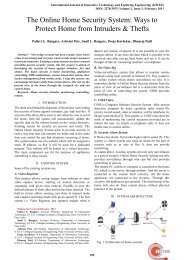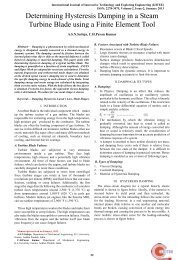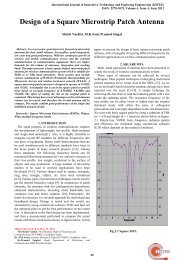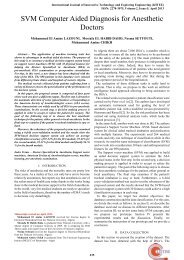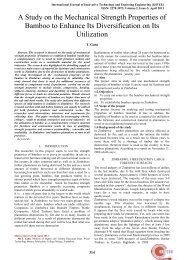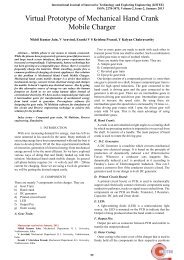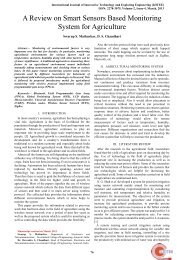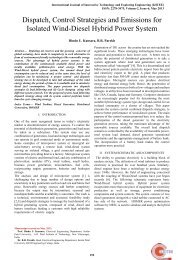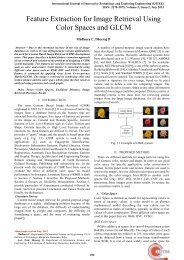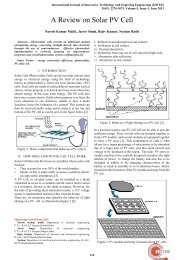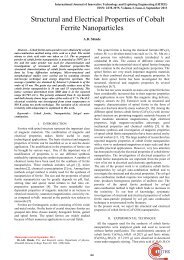Evaluation of Strength Characteristics of Concrete Using Crushed ...
Evaluation of Strength Characteristics of Concrete Using Crushed ...
Evaluation of Strength Characteristics of Concrete Using Crushed ...
- No tags were found...
You also want an ePaper? Increase the reach of your titles
YUMPU automatically turns print PDFs into web optimized ePapers that Google loves.
International Journal <strong>of</strong> Innovative Technology and Exploring Engineering (IJITEE)ISSN: 2278-3075, Volume-2, Issue-6, May 2013<strong>Evaluation</strong> <strong>of</strong> <strong>Strength</strong> <strong>Characteristics</strong> <strong>of</strong> <strong>Concrete</strong><strong>Using</strong> <strong>Crushed</strong> Stone Dust as Fine AggregateEr. Lakhan Nagpal, Arvind Dewangan, Er. Sandeep Dhiman, Er. Sumit KumarAbstract -- The purpose <strong>of</strong> this study was to investigate thepossibility <strong>of</strong> using crushed stone dust as fine aggregate partiallyor fully with different grades <strong>of</strong> concrete composites. Thesuitability <strong>of</strong> crushed stone dust waste as fine aggregate forconcrete has been assessed by comparing its basic properties withthat <strong>of</strong> conventional concrete. Two basic mixes were selected fornatural sand to achieve M25 and M30 grade concrete. Theequivalent mixes were obtained by replacing natural sand bystone dust partially and fully. The test result indicates thatcrushed stone dust waste can be used effectively used to replacenatural sand in concrete. In the experimental study <strong>of</strong> strengthcharacteristics <strong>of</strong> concrete using crushed stone dust as fineaggregate it is found that there is increase in compressivestrength , flexural strength and tensile strength <strong>of</strong> concrete.Keywords: concrete, strength, fine aggregate, crushed stone dust.I. INTRODUCTIONConventionally concrete is mixture <strong>of</strong> cement, sand andaggregate. Properties <strong>of</strong> aggregate affect the durability andperformance <strong>of</strong> concrete, so fine aggregate is an essentialcomponent <strong>of</strong> concrete. The most commonly used fineaggregate is natural river or pit sand. Fine and coarseaggregate constitute about 75% <strong>of</strong> total volume. It istherefore, important to obtain right type and good qualityaggregate at site, because the aggregate form the mainmatrix <strong>of</strong> concrete or mortar.The global consumption <strong>of</strong> natural sand is very high, due tothe extensive use <strong>of</strong> concrete. In general, the demand <strong>of</strong>natural sand is quite high in developing countries to satisfythe rapid infrastructural growth, in this situation developingcountry like India facing shortage in good quality naturalsand. Particularly in India, natural sand deposits are beingdepleted and causing serious threat to environment as wellas the society. Increasing extraction <strong>of</strong> natural sand fromriver beds causing many problems, loosing water retainingsand strata, deepening <strong>of</strong> the river courses and causing bankslides, loss <strong>of</strong> vegetation on the bank <strong>of</strong> rivers, exposing theintake well <strong>of</strong> water supply schemes, disturbs the aquaticlife as well as affecting agriculture due to lowering theunderground water table etc are few examples.In past decade variable cost <strong>of</strong> natural sand used as fineaggregate in concrete increased the cost <strong>of</strong> construction. Inthis situation research began for inexpensive and easilyavailable alternative material to natural sand.Manuscript received on May, 2013.Er. Lakhan Nagpal, A.P.-S.B. Institute <strong>of</strong> Engineering andTechnology,Kaithal,Haryana,India.Arvind Dewangan, Associate Pr<strong>of</strong>essor-H.C.T.M.TechnicalCampus,Kaithal,Haryana,India.Er. Sandeep Dhiman, A.P.-E-MAX School <strong>of</strong> Engineering and AppliedResearch, Ambala, Haryana,India.Er. Sumit Kumar, A.P.-Gateway Institute <strong>of</strong> Engineering andTechnology,Sonipat,Haryana, India.Some alternatives materials have already been used as a part<strong>of</strong> natural sand e.g. flyash, slag limestone and siliceousstone powder were used in concrete mixtures as a partialreplacement <strong>of</strong> natural sand.However, scarcity in required quality is the major limitationin some <strong>of</strong> the above materials. Now a day’s sustainableinfrastructural growth demands the alternative material thatshould satisfy technical requisites <strong>of</strong> fine aggregate as wellas it should be available abundantly.II. LITERATURE REVIEWCommon river sand is expensive due to excessive cost <strong>of</strong>transportation from natural sources. Also large-scaledepletion <strong>of</strong> these sources creates environmental problems.As environmental transportation and other constraints makethe availability and use <strong>of</strong> river sand less attractive, asubstitute or replacement product for concrete industryneeds to be found. River sand is most commonly used fineaggregate in the production <strong>of</strong> concrete poses the problem <strong>of</strong>acute shortage in many areas. Whose continued use hasstarted posing serious problems with respect to itsavailability, cost and environmental impact?Materials And MethodsCementOrdinary Portland Cement (43 Grade) with 28 percentnormal consistency Conforming to IS: 8112-1989 [3] wasused.Quarry rock dustThe Quarry Rock Dust obtained from local resource AMCCrushers (P) Ltd., Dindigul was used in concrete to cast testcubes and beams. The physical and chemical properties <strong>of</strong>Quarry Rock Dust obtained by testing the samples as perIndian Standards are listed in Tables 1 and 2, respectively.Fine aggregate (Natural river sand)River sand having density <strong>of</strong> 1460 kg/m 3 and finenessModulus (FM) <strong>of</strong> 2.51 was used. The specific gravity wasfound to be 2.6.Coarse aggregateNatural granite aggregate having density <strong>of</strong> 2700kg/m 3 andfineness modules (FM) <strong>of</strong> 6.80 was used. The specificgravity was found to be 2.60 and water absorption as 0.45%.AdmixtureCommercially available Super-plasticiser has been used toenhance the workability <strong>of</strong> fresh concrete for selectedproportions <strong>of</strong> ingredients.Mix DesignSince there is No standard method <strong>of</strong> designing concretemixes incorporating Quarry Rock Dust as fine Aggregate.The method mix design proposed by IS, ACI, USBR, RNNo.4, BS were first employed to design the Conventional<strong>Concrete</strong> mixes and finally natural sand was fully replacedby Quarry Rock Dust to obtain Quarry Rock Dust concretemixes. The purpose <strong>of</strong> mix proportioning is to produce the102
<strong>Evaluation</strong> <strong>of</strong> <strong>Strength</strong> <strong>Characteristics</strong> <strong>of</strong> <strong>Concrete</strong> <strong>Using</strong> <strong>Crushed</strong> Stone Dust as Fine Aggregaterequired properties in both plastic and hardened concrete byworking out a combination <strong>of</strong> available materials, withvarious economic and practical standards.III. RESEARCH SIGNIFICANCEBased on the above discussions, following conclusions aredrawn:(a) The Physical and chemical properties <strong>of</strong> quarry rock dustis satisfied the requirements <strong>of</strong> code provision in propertiesstudies Natural river sand, if replaced by hundred percentQuarry Rock Dust from quarries, may sometimes give equalor better than the reference concrete made with NaturalSand, in terms <strong>of</strong> compressive and flexural strength studies(b) Studies reported here and elsewhere have shown that thestrength <strong>of</strong> Quarry Rock Dust concrete is comparatively 10-12 percent more than that <strong>of</strong> similar mix <strong>of</strong> Conventional<strong>Concrete</strong>. Also the result <strong>of</strong> this investigation shows thatdrying shrinkage strains <strong>of</strong> Quarry Rock Dust concrete arequite large to the shrinkage strain <strong>of</strong> Conventional <strong>Concrete</strong>.However, at the later age, they have shown equal strain thanConventional <strong>Concrete</strong>. The Durability <strong>of</strong> Quarry Rock Dustconcrete under sulphate and acid action is higher inferior tothe Conventional. Permeability Test results clearlydemonstrates that the permeability <strong>of</strong> Quarry Rock Dustconcrete is less compared to that <strong>of</strong> conventional concrete.The water absorption <strong>of</strong> Quarry Rock Dust concrete isslightly higher than Conventional <strong>Concrete</strong>. Therefore, theresults <strong>of</strong> this study provide a strong support for the use <strong>of</strong>Quarry Rock Dust as fine aggregate in <strong>Concrete</strong>Manufacturing.IV.REFERENCES[1]. Prakash Rao D.S. and Gridhar V. 2004. Investigation on <strong>Concrete</strong>with Stone crusher dust as Fine aggregate. The Indian concreteJournal. pp. 45-50.[2]. Sahu A.K., Sunil Kumar and Sachan A.K. 2003. Quarry Stone Wasteas Fine aggregate for concrete. The Indian <strong>Concrete</strong> Journal. pp. 845-848.[3]. Ilangovan R. and Nagamani K. 2006. Studies on <strong>Strength</strong> andBehavior <strong>of</strong> <strong>Concrete</strong> by using Quarry Dust as Fine Aggregate. CEand CR Journal, New Delhi. October. pp. 40-42.[4]. Ilangovan R. and Nagamani K. 2006. Application <strong>of</strong> quarry Rock dustas fine aggregate in concrete construction. National Journal onconstruction Management: NICMR. Pune. December. pp. 5-13.[5]. Ilangovan, R.; Nagamani, K., and Kumarasamy, K.,“Studies onstrength and behaviour <strong>of</strong> concrete by using crushed rock dust as fineaggregate,” Civil Engineering and Construction Review, October2006, pp. 924-932.103
International Journal <strong>of</strong> Innovative Technology and Exploring Engineering (IJITEE)ISSN: 2278-3075, Volume-2, Issue-6, May 2013Er. Lakhan Nagpal[Corresponding Author] : At presentworking as an faculty member in Civil EngineeringDepartment at S.B. Institute <strong>of</strong> Engineering andTechnology,Kaithal,HaryanaDr. Arvind Dewangan: Dr. Arvind Dewangan,Associate Pr<strong>of</strong>essor in Department <strong>of</strong> Civil Engineering,Haryana College <strong>of</strong> Technology & Management,Technical Campus KAITHAL. His highest academicqualification is PhD in Mining & GeologicalEngineering. He has 12years <strong>of</strong> experience in teachingand research. He has published 41 papers inInternational and National journals and won more than 15 timesNATIONAL LEVEL ESSAY COMPETITION.Er. Sandeep Dhiman : At present working as afaculty member in Civil Engineering Department atE-MAX School <strong>of</strong> Engineering and Applied Research, Ambala ,Haryana, A.P.Er. Sumit Kumar:At present working as a facultymember in Civil Engineering Department atGateway Institute <strong>of</strong> Engineering and Technology,Sonipat, Haryana104



